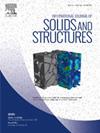Characterization of orientational order for arbitrary-shaped particles and its applications in granular assemblies
IF 3.4
3区 工程技术
Q1 MECHANICS
International Journal of Solids and Structures
Pub Date : 2025-02-03
DOI:10.1016/j.ijsolstr.2025.113257
引用次数: 0
Abstract
Within granular assemblies, different arrangement structures of the particles can also affect the macroscopic mechanical properties of the system. Characterizing the particle order parameter is a prerequisite for studying the properties of the system. The order parameter of arbitrarily shaped particle can be characterized by Wigner D-matrices or the super-tensor basis, and the super-tensor basis more clearly explains the physical meaning of the order parameter. However, the expressions for the super-tensor basis are complex, and explicit expressions for orders higher than three are rarely provided in the literature. This paper reveals the relationship between the super-tensor basis and the projection operators, which decomposes symmetric tensors into irreducible tensors. Explicit expression for the projection operator is provided, and the consistency with the existing recursive expression and differential expression is demonstrated. Based on this, the expression for super-tensor basis of any order is derived, and the orthogonality of super-tensor basis is provided. Finally, the sound propagation in a biaxial super-ellipsoid particle system is simulated by the discrete element method, and the sound velocity is also calculated. The results indicate that different arrangement structures can affect the sound velocity. From the perspectives of order parameter and elastic moduli, the differences in sound velocities of different packing structures are explained. The explicit expressions of the projection operator and the super-tensor basis provided in this paper facilitate the convenient calculation of the anisotropy of other physical quantities within the system, which can be utilized to elucidate the macroscopic mechanical properties of the system.
任意形状粒子的取向顺序表征及其在颗粒组合中的应用
在颗粒组合中,颗粒的不同排列结构也会影响系统的宏观力学性能。粒子序参量的表征是研究系统性质的前提。任意形状粒子的序参量可以用维格纳d矩阵或超张量基来表征,超张量基更清晰地解释了序参量的物理意义。然而,超张量基的表达式是复杂的,并且在文献中很少提供高于三阶的显式表达式。揭示了将对称张量分解为不可约张量的超张量基与投影算子之间的关系。给出了投影算子的显式表达式,并证明了其与现有递归表达式和微分表达式的一致性。在此基础上,导出了任意阶超张量基的表达式,并给出了超张量基的正交性。最后,用离散元法模拟了双轴超椭球粒子系统中声音的传播,并计算了声速。结果表明,不同的排列结构对声速有影响。从序参量和弹性模量的角度解释了不同填料结构的声速差异。本文提供的投影算子和超张量基的显式表达式,方便了系统内其他物理量的各向异性计算,可用于阐明系统的宏观力学性能。
本文章由计算机程序翻译,如有差异,请以英文原文为准。
求助全文
约1分钟内获得全文
求助全文
来源期刊
CiteScore
6.70
自引率
8.30%
发文量
405
审稿时长
70 days
期刊介绍:
The International Journal of Solids and Structures has as its objective the publication and dissemination of original research in Mechanics of Solids and Structures as a field of Applied Science and Engineering. It fosters thus the exchange of ideas among workers in different parts of the world and also among workers who emphasize different aspects of the foundations and applications of the field.
Standing as it does at the cross-roads of Materials Science, Life Sciences, Mathematics, Physics and Engineering Design, the Mechanics of Solids and Structures is experiencing considerable growth as a result of recent technological advances. The Journal, by providing an international medium of communication, is encouraging this growth and is encompassing all aspects of the field from the more classical problems of structural analysis to mechanics of solids continually interacting with other media and including fracture, flow, wave propagation, heat transfer, thermal effects in solids, optimum design methods, model analysis, structural topology and numerical techniques. Interest extends to both inorganic and organic solids and structures.

 求助内容:
求助内容: 应助结果提醒方式:
应助结果提醒方式:


